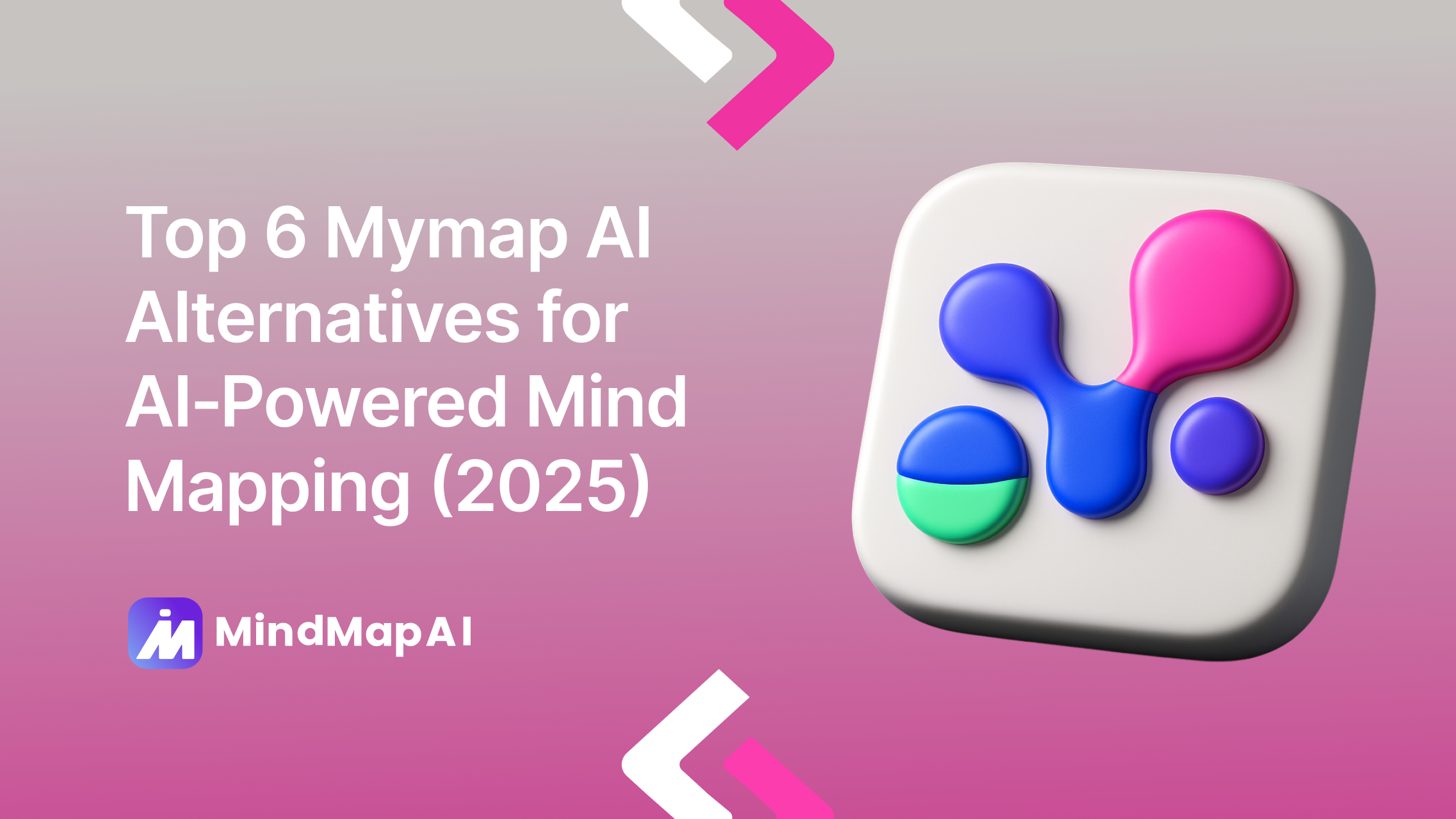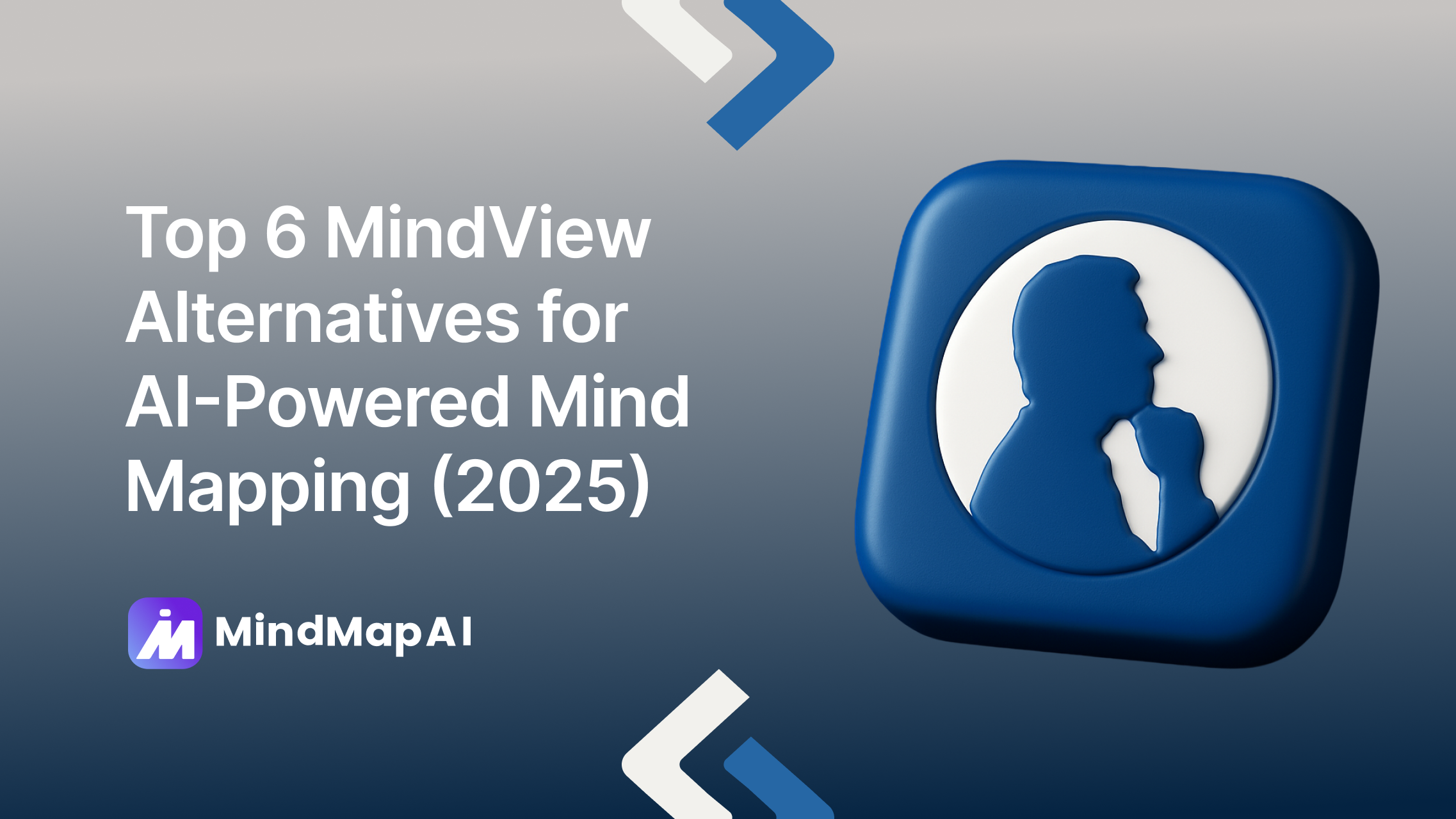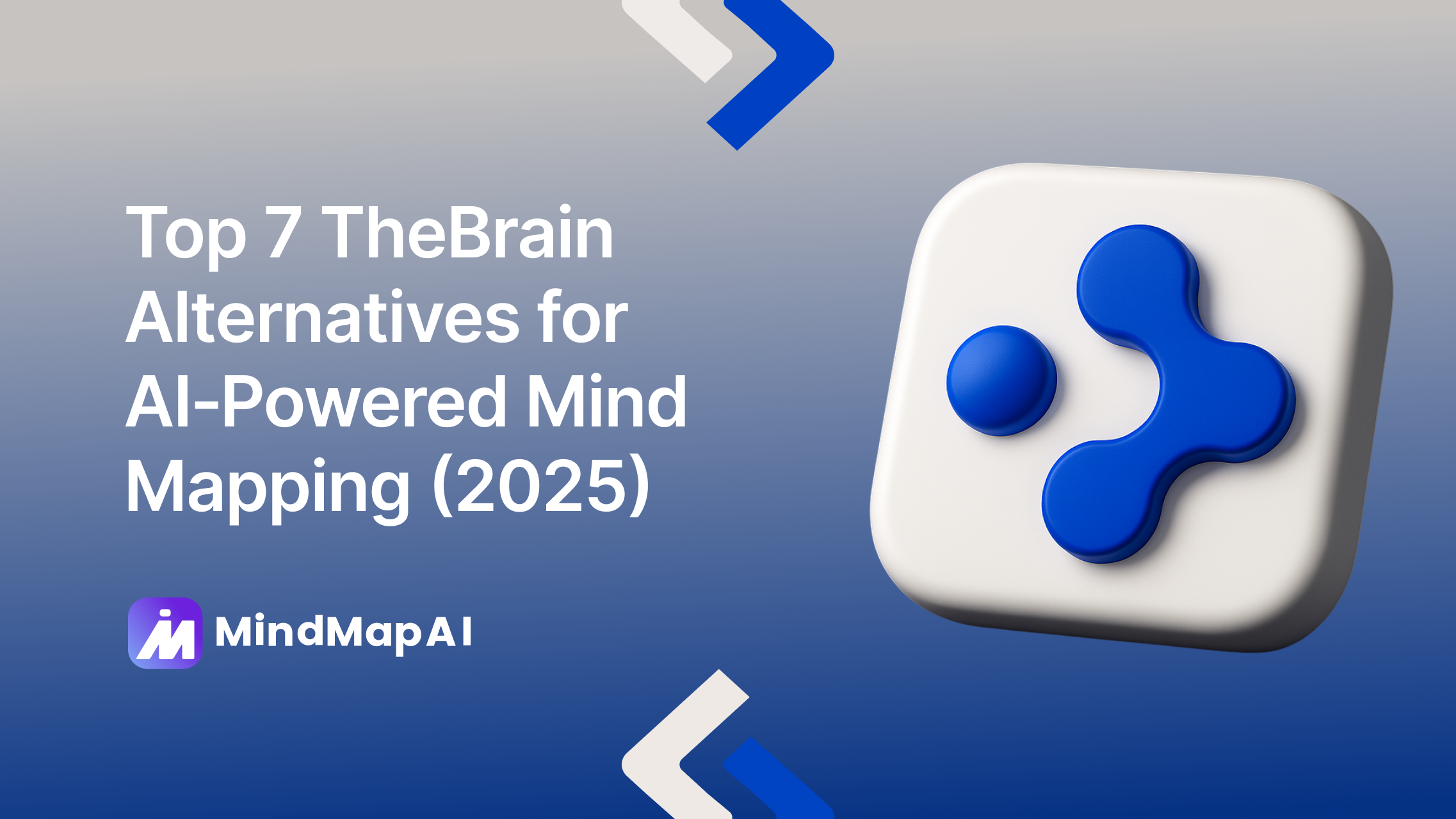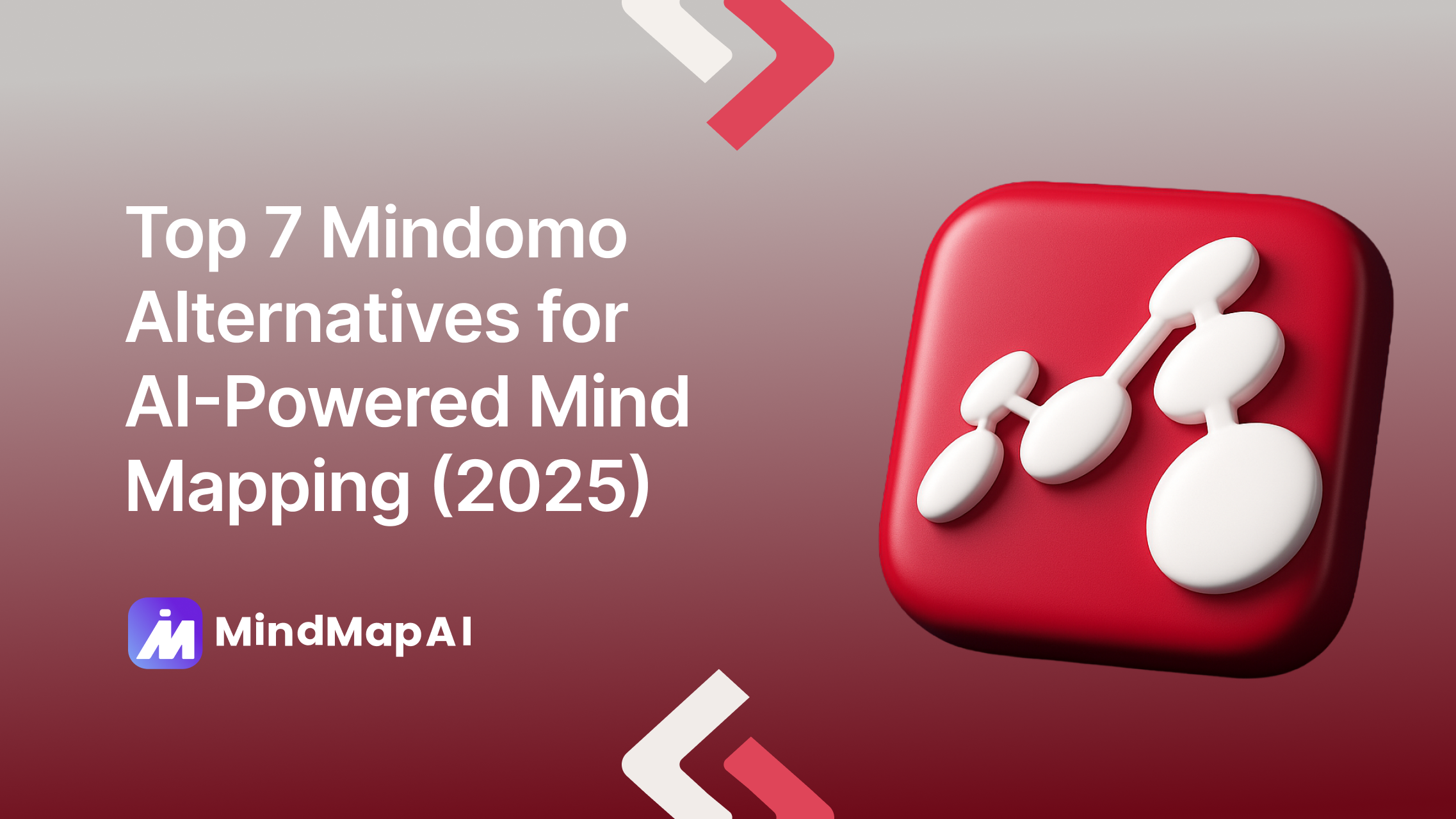
Top 7 Mindomo Alternatives for AI-Powered Mind Mapping (2025)
Mindomo is a versatile mind mapping tool offering real-time collaboration, offline editing, AI assistance, and a vast template library for business, education, and personal productivity. With support for mind maps, concept maps, outlines, and Gantt charts, it caters to diverse needs from classroom learning to corporate project management.
Still, Mindomo might not be the perfect fit for everyone. Some users may want a sleeker AI experience, broader file import options, or more advanced automation for summarizing and expanding ideas. Others may be looking for tools with richer design customization, tighter app integrations, or unique AI-powered brainstorming features.
That’s why we’ve rounded up the best Mindomo alternatives for 2025. Whether you’re a student, educator, entrepreneur, or project manager, these tools deliver fresh approaches to AI-powered mind mapping, offering flexibility, speed, and creative freedom.
Ready to map more than just PDFs?
1. MindMap AI

Why it stands out
MindMap AI redefines the mind mapping experience as a powerful alternative to Mindomo by combining speed, AI intelligence, and multi-format flexibility. Users can instantly turn PDFs, CSV files, videos, audio recordings, images, or text into a structured, first-draft mind map in seconds, eliminating the manual effort required by traditional tools. Once the initial map is generated, the on-canvas Copilot Chat enables real-time refinement - summarizing nodes, expanding branches, or focusing on specific topics using natural-language commands.
At the same time, AI-driven Second-Order Connections automatically detect hidden links and relationships across your map, uncovering insights that might otherwise be missed. By merging rapid generation, deep AI-assisted analysis, and broad input or output support, MindMap AI offers users a fast, flexible, and cost-effective mind mapping solution, making it the standout choice among Mindomo alternatives in 2025.
Key Features
Instant multi-format input: Drop audio, PDF, image, video, text, or CSV and MindMap AI lays out a clean, editable mind map in seconds.

Copilot & Context Menu: Type prompts or use Context menu for AI Tools to AI expand, AI summarise, and the AI focus topic.

Unlimited undo/redo with version snapshots & generous free plan: Every edit is auto-saved so you can roll back anytime, and the Free tier still packs 100 monthly AI credits plus unlimited manual maps.

Second-Order Connections: An AI routine that surfaces hidden links between branches, accelerating tasks like research cross-referencing and SWOT analysis.

Pros
Continuous AI Chat: Real-time Copilot assistance keeps brainstorming dynamic, ask follow-up questions or expand ideas without interrupting your flow.
Smart Summarization & AI Topic Focus: Quickly reduce complex branches or zoom in on one topic using plain-language commands.
Multi-format File Conversion: Generate an editable map from text, PDFs, images, audio, video, or CSV in one click, no manual setup required.
Edit and Retry Prompts: Didn’t love the first draft? Retry or refine your prompt infinitely without spending extra credits.
Flexible Pricing Options: Choose from annual Basic ($45/yr) and Pro ($90/yr) plansor grab a lifetime license with add-on credits available for peak usage.
Cons
No Real-Time Collaboration: Lacks simultaneous co-editing; teams must share links rather than work together live.
Pricing
Free: $0/mo - 100 AI credits + unlimited manual maps
Basic: $7.49/mo - 2 000 AI credits
Pro: $14.99/mo - 5 000 AI credits.
Curious how MindMap AI stacks up against Mindomo?
2. TheBrain

Why it stands out
TheBrain goes beyond traditional mind mapping by creating an infinite, bi-directional “second brain” where every idea, note, or file can connect dynamically. Its AI-assisted features allow you to generate new thoughts, titles, and summaries, helping ideas evolve over time. With 30 GB of cloud storage and fully offline desktop apps for Windows, macOS, and Linux, TheBrain ensures your knowledge is always accessible.
Semantic search enables users to locate relationships and insights across years of stored data, making it a top choice for academics, researchers, and professionals seeking long-term personal knowledge management.
Key Features
Unlimited bi-directional nodes: Connect ideas non-linearly for a flexible knowledge network.
Cross-platform sync: Desktop, mobile, and web access with 30 GB cloud backup.
AI-powered prompts: Generate new ideas, summaries, and titles to expand your knowledge graph.
Pros
True “second brain” functionality that scales with your knowledge over time.
Perpetual desktop license allows offline access even if cloud subscription ends.
Ideal for complex projects research, or personal knowledge management.
Cons
Steeper learning curve compared to simpler, radial mind mappers.
Higher cost than many web-based alternatives: first-year Pro Combo at US $299, renewing at $159/year.
No native Gantt or project management views for task tracking.
Pricing
Pro Combo: $299 for the first year, including desktop license, AI integration, and 30 GB cloud storage.
Renewal: $159/year for continued cloud services and updates.
3. Xmind AI
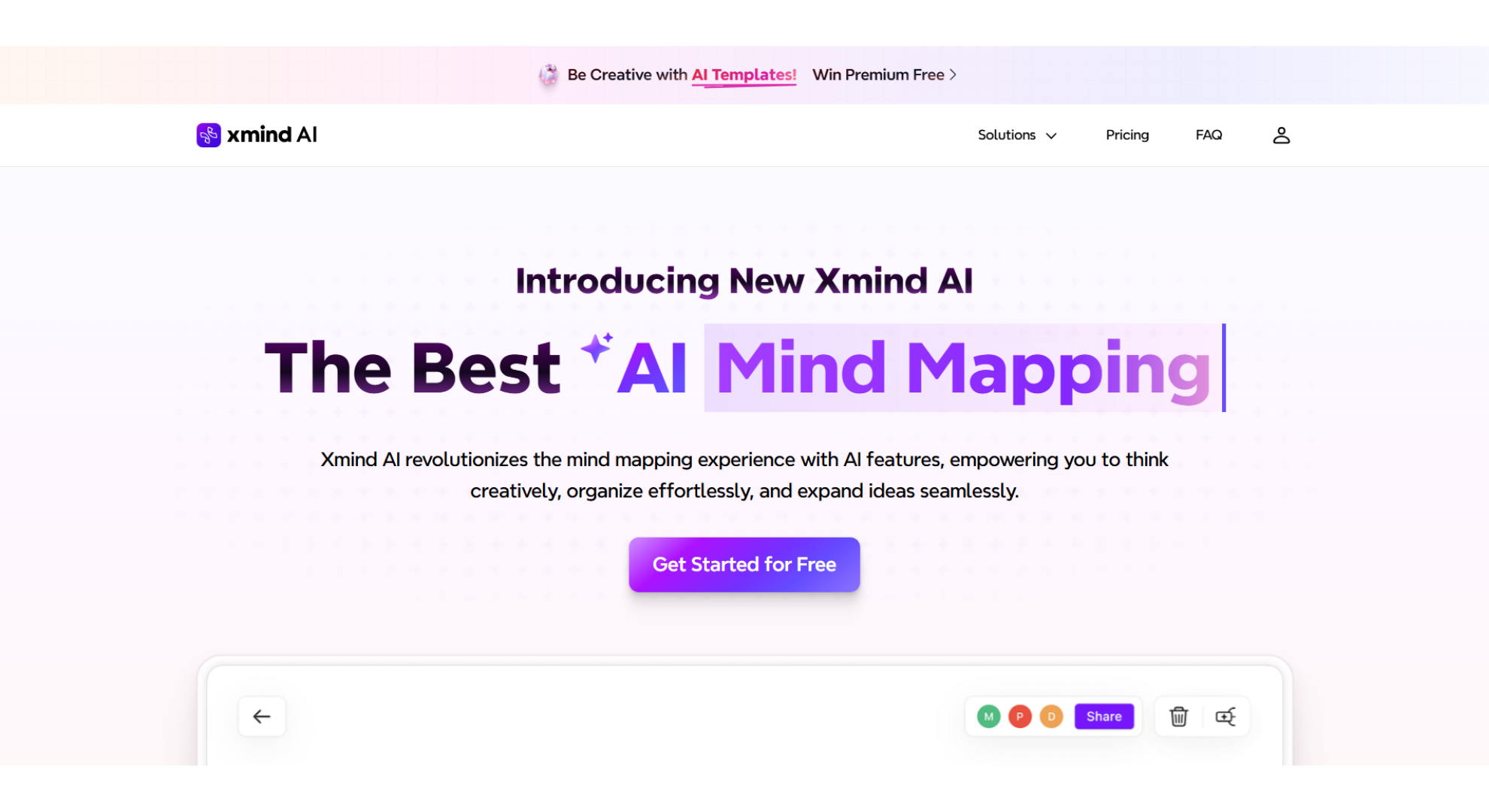
Why it stands out
Xmind AI combines the trusted Xmind desktop experience with cutting-edge AI assistance. The GPT-powered Copilot provides real-time brainstorming, summarization, and to-do generation, allowing users to quickly refine ideas without leaving the map. Multiple layouts including timeline, fishbone, logic charts, org charts, and tree structures cater to diverse planning and analytical needs.
Version control ensures that your work is safe with a 30-day history, while support for legacy .xmind files makes it easy to continue older projects seamlessly. Its offline-first design ensures uninterrupted productivity, with AI credits only consumed when AI functions are actively used.
Key Features
Multi-structure layouts: Timeline, fishbone, logic chart, org chart, and tree view for versatile mapping.
Version history: 30-day backup to protect previous versions of your work.
Cross-platform support: Desktop apps for Windows, macOS, Linux, and a web beta with live cursors for collaboration.
Pros
Fully offline workflow with AI credits only deducted upon usage.
Affordable AI credit top-ups: 500 credits for US $3.99.
Familiar Xmind interface, minimizing the learning curve for existing users.
Cons
No automatic ingestion of PDFs or video files; content must be added manually.
Web beta is still catching up to the desktop version in terms of refinements and responsiveness.
Pricing
Premium Plan: US $8.25/month with 500 AI credits included.
Optional AI credit top-ups available separately.
4. Whimsical
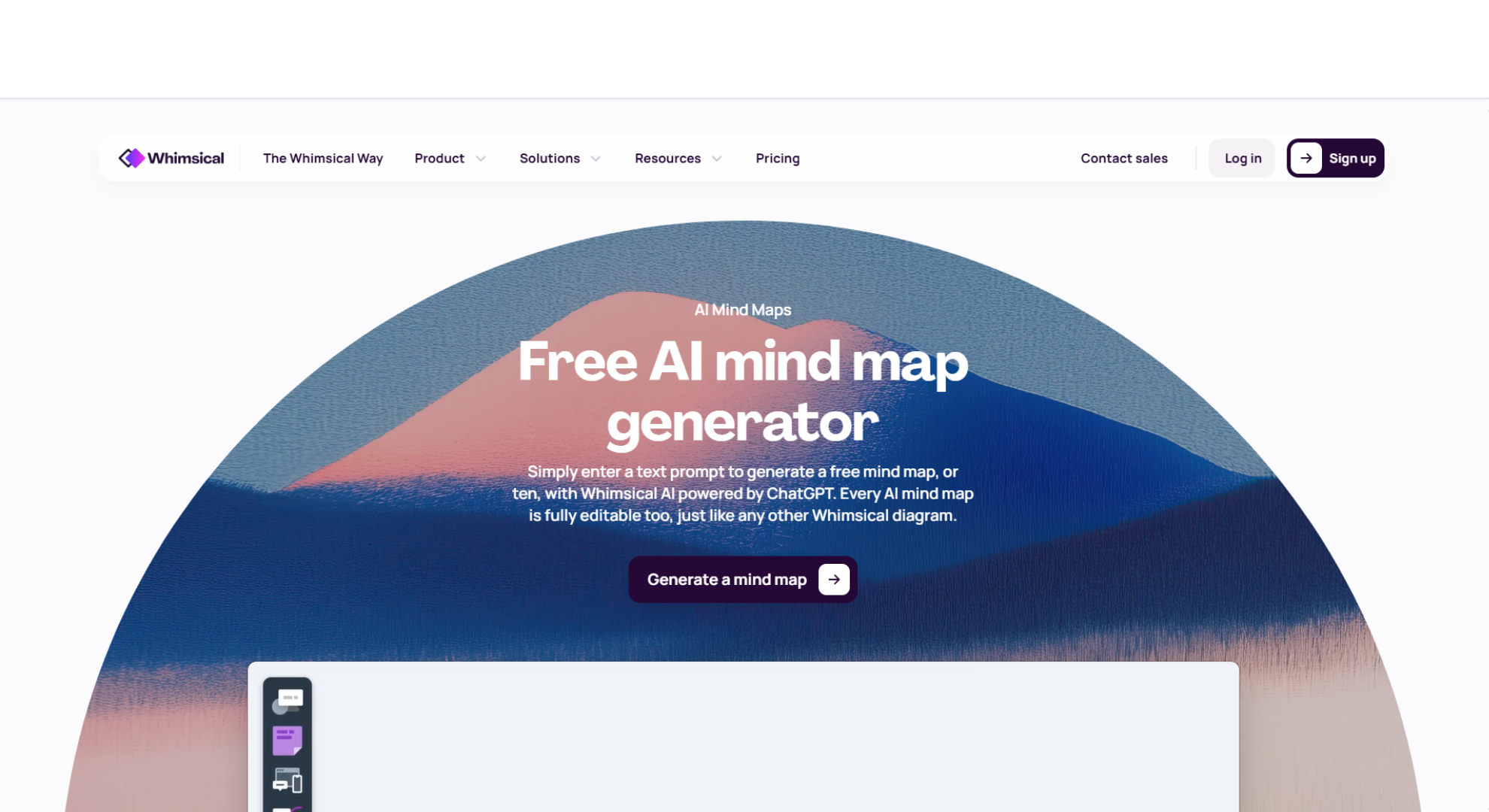
Why it stands out
Whimsical provides an all-in-one infinite canvas where mind maps, flowcharts, wireframes, sticky notes, and documents coexist seamlessly. Its AI-assisted features transform simple notes or bullet points into polished, visually engaging diagrams in seconds, making it especially valuable for design, product, and creative teams. Collaboration is enhanced with Figma-style comments, emoji reactions, timers, and voting tools, enabling interactive workshops, brainstorming sessions, and planning exercises.
Startups can leverage a one-year free Pro subscription, while the intuitive interface ensures most users can start mapping ideas immediately without extensive onboarding. Its flexibility and visual richness make Whimsical a standout tool for teams needing clarity and engagement across remote or hybrid workflows.
Key Features
AI-assisted diagramming: 500 AI actions per editor per month on Pro, 1,000 on Business.
Collaboration tools: Figma-style comments, emoji reactions, timers, and voting for interactive sessions.
Startup benefits: Eligible startups receive a one-year Pro subscription free.
Pros
Clean, beautiful interface with minimal learning curve.
Generous free tier for individuals or small teams (3 boards, 100 AI actions total).
Flexible, real-time collaboration tools suitable for teams of any size.
Cons
No native Gantt chart or Kanban-style project views, limiting formal project management.
File import is restricted to URLs and board uploads; other media types require workarounds.
Pricing is calculated per editor, which can increase costs for larger teams.
Pricing
Free: Limited boards with 100 AI actions total.
Pro: $10/editor/month.
Business: $15/editor/month.
Enterprise: $20/editor/month (annual billing).
5. MindGenius Online
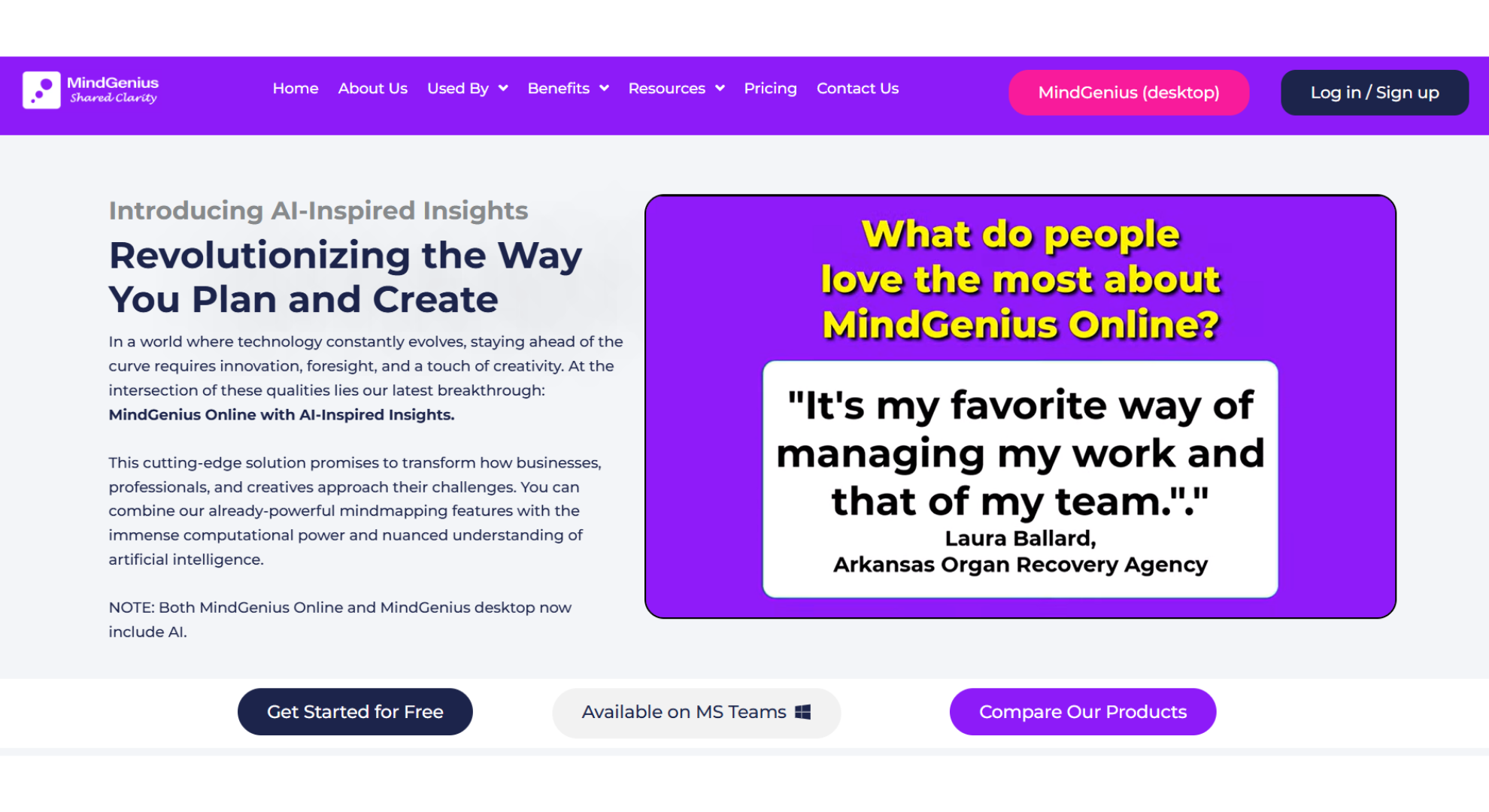
Why it stands out
MindGenius Online combines the flexibility of an infinite whiteboard with AI-assisted mind mapping, allowing users to create flowcharts, wireframes, sticky notes, and traditional mind maps on a single canvas. Its AI actions 500 per editor per month on Pro and 1,000 on Business can automatically turn bullet points or notes into polished diagrams, speeding up ideation and planning.
Collaboration is enhanced with Figma-style comments, quick emoji reactions, timers, and voting tools, making it ideal for design teams, startups, and distributed teams. Eligible startups can also enjoy a one-year free Pro plan, making the platform accessible for early-stage companies. The interface is clean and intuitive, requiring minimal onboarding, which allows users to start visualizing ideas immediately.
Key Features
AI-assisted diagramming: Automatically convert notes and bullet points into visual diagrams.
Collaboration tools: Figma-style comments, emoji reactions, timers, and voting for interactive sessions.
Startup benefits: One-year Pro plan free for eligible startups.
Pros
Intuitive, visually appealing interface with minimal learning curve.
Generous free tier: 3 boards and 100 AI actions for quick experimentation or small projects.
Real-time collaboration tools enhance brainstorming and team alignment.
Cons
No native Gantt chart or Kanban-style project views.
File import is limited to URLs and board uploads; other media types are not natively supported.
Pricing per editor can scale up for larger teams.
Pricing
Free: Limited boards with 100 AI actions total.
Pro: US $10/editor/month.
Business: US $15/editor/month.
6. Mapify
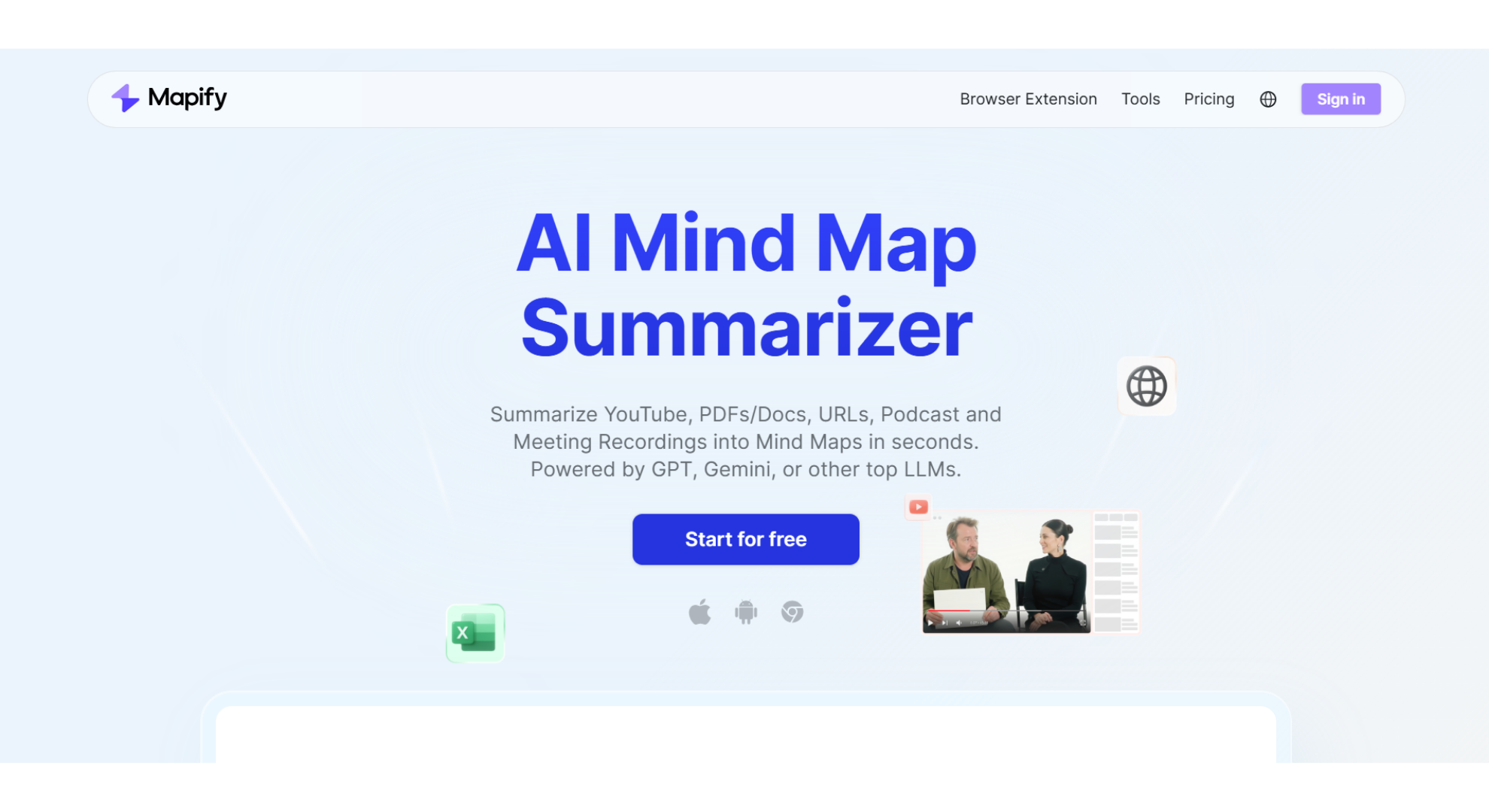
Why it stands out
Mapify excels at transforming dense content into structured visual insights in seconds. Simply drag in PDFs, PowerPoint slides, or YouTube links, and Mapify generates a clean, radial mind map along with an optional slide deck. Its built-in AI chatbot allows follow-up questions, highlights key points, and refines ideas on the canvas, while multilingual support ensures content can be translated into over 30 languages.
These features make it a strong choice for students, researchers, and professionals who need rapid, actionable insights from large volumes of content, all within a simple, budget-friendly interface.
Key Features
File-to-map conversion: Instantly turn PDFs, PPTs, docs, URLs, or YouTube videos into radial mind maps.
Multilingual support: Translate content into 30+ languages.
Slide deck export: One-click export of maps into editable presentations.
Pros
Extremely fast content ingestion, saving time on research and planning.
Intuitive and clean interface requiring minimal learning curve.
Supports multi-format content (video, document, PDF, URL).
Cons
Only supports radial layouts: no Kanban or Gantt-style project views.
Basic tier is limited: to 1,000 AI credits per month.
Advanced AI capabilities: require paid tiers.
Pricing
Basic: US $9.99/month (often $5.99 with a 40% promotion) – capped at 1,000 AI credits.
Pro: US $19.99/month.
Unlimited: US $29.99/month for unrestricted credits and features.
7. MyMap AI
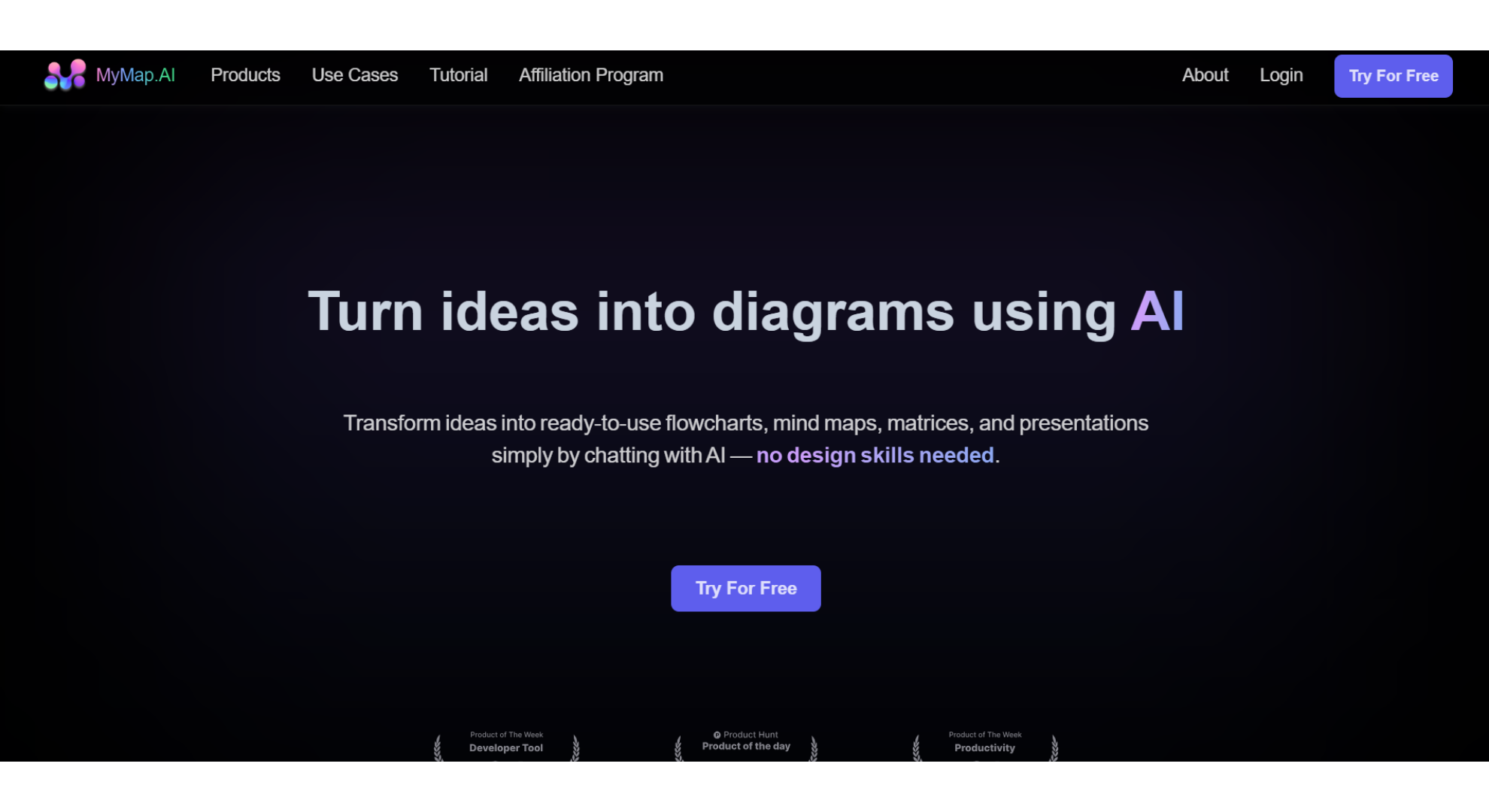
Why it stands out
MyMap AI turns conversational input into structured visual diagrams in seconds. Just type a prompt like “Plan a product launch,” and the platform instantly generates a color-coded mind map, flowchart, or slide outline. Its chat-native canvas allows teams to brainstorm in real-time without worrying about manual node placement.
With live web search integration, users can enrich maps with up-to-date content, making it particularly effective for research, sales planning, lesson preparation, and content creation. The tool’s intuitive interface ensures that even users without prior design experience can produce professional-quality visuals quickly.
Key Features
Talk-to-diagram assistant: Convert text prompts directly into mind maps, flowcharts, and slides.
Multi-format support: Upload multiple file types and export as PNG or PDF.
Web search enrichment: Incorporate live data from Google or Bing into your maps.
Pros
Extremely low learning curve thanks to a conversational interface.
Rapid idea generation for creative and operational tasks.
Suitable for students, researchers, professionals, and content creators
Cons
Free plan limits users to 5 AI credits per day.
Paid tiers are comparatively more expensive than some alternatives.
Limited integrations with third-party apps.
Pricing
Plus: US $15/user/month (or $9 billed yearly).
Pro: US $20/month.
Team Pro: US $25/month.
Not sure which fits your workflow?
Quick comparison
| Tool | Paid entry price | Included AI quota | Stand-out strength |
|---|---|---|---|
| MindMap AI | US $ 7.49/mo | 2 000 credits | Broadest file intake |
| TheBrain 14 | US $ 24.9/mo* | 500 credits/day | Infinite graph |
| Xmind AI | US $ 8.25/mo | 500 credits/mo | Offline desktop |
| Whimsical | US $ 10/editor/mo | 500 actions/mo | Design-centric canvas |
| MindGenius Online | ~US $ 12.8/seat/mo | Idea prompts | Map → Timeline/Taskboard |
| Mapify | US $ 9.99/mo | 1 000 credits | File-to-map speed |
| MyMap AI | US $ 15/user/mo | 5 credits/day free | Chat-driven diagrams |
FAQ
Q: What is the best alternative to Mindomo in 2025?
A: The best all-round alternative is MindMap AI, which transforms PDFs, images, audio, video, and CSVs into clean maps in seconds. For users who prefer long-term personal knowledge graphs, TheBrain is also a strong choice.
Q: Which Mindomo alternative is best for educators?
A: MindMap AI supports flexible exports (PDF, PNG, Markdown), which makes lesson planning easy. Whimsical is also popular with educators for its infinite whiteboard and simple collaboration features.
Q: What is the cheapest Mindomo alternative?
A: Mapify is affordable with plans starting around $9.99/month (often discounted). For high value under $10, MindMap AI provides 2,000 credits for $7.49/month.
Q: Which tool exports the most formats?
A: MindMap AI supports the widest range of export formats, including Markdown, PDF, PNG, CSV, and SVG. Mapify also offers fast slide-deck exports for presentations.
Q: Which tool has the most powerful AI features?
A: MindMap AI leads with AI Copilot, Summarizer, and second-order connections for hidden links. If you need conversational diagramming, MyMap AI is also strong with its “chat-to-map” interface.
Final Takeaway
Mindomo’s combination of collaboration features, offline access, and multiple diagram types makes it a strong all-rounder; but it’s far from your only option. The best Mindomo alternatives introduce new ways to visualize ideas, automate map creation, and handle a wider range of content formats.
MindMap AI stands out among them, offering instant AI-generated mind maps from PDFs, videos, images, audio, and more. Its AI Expand, Summarize, and Focus Topic features make it easy to dive deeper or shorten complex topics, while flexible export options.
If you’re looking to combine Mindomo’s collaborative spirit with more powerful AI creativity and automation, MindMap AI is well worth exploring.





